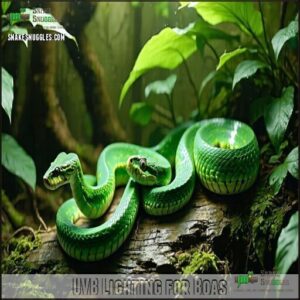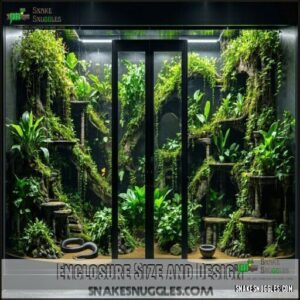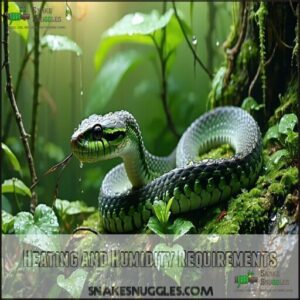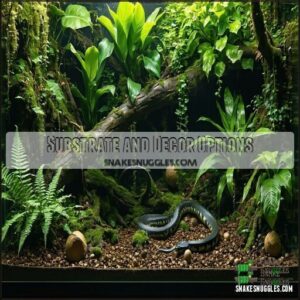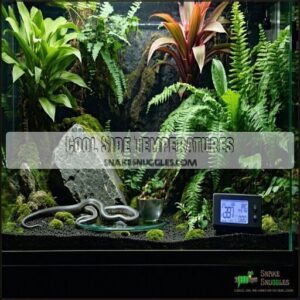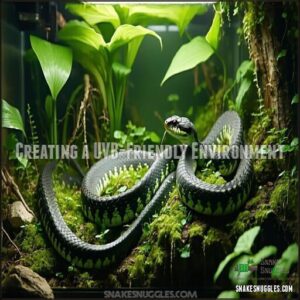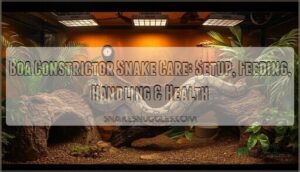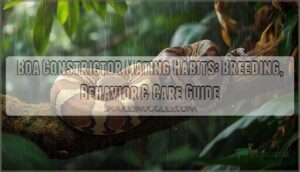This site is supported by our readers. We may earn a commission, at no cost to you, if you purchase through links.
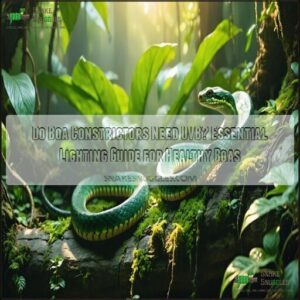 Boa constrictors don’t technically need UVB lighting to survive, but a little UVB can go a long way in supporting their health.
Boa constrictors don’t technically need UVB lighting to survive, but a little UVB can go a long way in supporting their health.
They produce vitamin D with its help, which strengthens their immune system, and might even improve their overall well-being.
Think of it as giving them a touch of sunlight in their enclosure. Just make sure to use low-level UVB bulbs, as boas don’t need intense lighting like some reptiles.
Place the lamp where they can bask but also move away if they’d rather chill in the shade. Curious about how to balance UVB with heat and humidity? We’ve got that covered.
Table Of Contents
- Key Takeaways
- Boa Constrictor UVB Needs
- Do Boas Need UVB Lighting
- Boa Constrictor Lighting Requirements
- UVB Lighting for Boas
- Boa Constrictor Enclosure Setup
- UVB and Temperature Gradients
- Humidity and UVB Interaction
- Boa Constrictor Health and UVB
- Creating a UVB-Friendly Environment
- Optimizing Boa Constrictor Care
- Frequently Asked Questions (FAQs)
- Conclusion
Key Takeaways
- You don’t have to provide UVB for boa constrictors, but doing so can improve their health and well-being by boosting vitamin D production and immunity.
- Use low-level UVB bulbs to enhance your snake’s well-being without overexposure, and replace bulbs annually to maintain effectiveness and safety.
- Make sure there’s a balance of UVB, heat, and humidity in the enclosure to prevent health issues and disruptions to their natural cycles.
- Position the UVB lamp carefully so your boa has areas to bask in light or escape to the shade as needed to maintain a natural environment.
Boa Constrictor UVB Needs
Boa constrictors don’t strictly need UVB lighting, but it can greatly benefit their health over time.
UVB lighting enhances boa constrictor health, boosting immunity, mental well-being, and natural cycles for a happier, thriving snake.
Understanding their UVB requirements helps you provide the best care possible for your boa.
Importance of UVB Lighting
Not every snake needs UVB, but providing it raises care standards.
UVB benefits go beyond survival, enhancing your boa’s long-term health and mental wellbeing, supporting natural cycles and immunity.
- Boosts vitamin D synthesis for better calcium absorption
- Promotes a healthy day-night cycle
- Strengthens immunity, aiding overall health, which is why skipping UVB for a minimalist care approach may not be ideal.
Benefits of UVB for Boas
UVB for snakes, like boa constrictors, offers more than just Vitamin D synthesis. It boosts their immune system, supports mental health, and enhances activity levels.
Good lighting mimics natural sunlight, promoting better long-term wellbeing. Here’s how UVB benefits boas:
| Benefit | Impact | Example |
|---|---|---|
| Vitamin D Synthesis | Stronger bones | Healthier muscle function |
| Immune System Boost | Fewer illnesses | Quicker recovery |
| Mental Health | Active behaviors | Reduced stress |
UVB and Health Risks
While UVB lighting offers benefits, improper use can harm boa health.
Overexposure may result in metabolic issues, vitamin D toxicity, or even eye and skin damage.
To maintain boa constrictor UVB benefits safely:
- Keep UVB lamps at manufacturer-recommended distances.
- Replace bulbs every 12 months to avoid diminished output.
- Monitor snake health for growth rates or behavioral changes linked to UVB deficiency.
Do Boas Need UVB Lighting
Boa constrictors are remarkable reptiles, but meeting their UVB needs can spark plenty of questions.
Do snakes need UVB lighting? While not strictly required, UVB light for boas offers long-term health benefits.
Studies suggest UVB exposure improves mental health, vitamin D production, and immune support.
Even nocturnal boas, although active mainly at night, benefit from proper daytime UVB.
It’s a game-changer for a higher care standard.
A basking UVI level of 2.0-3.0 hits the sweet spot, aligning with boa UVB requirements.
Remember, the lamp distance matters—follow manufacturer guidelines.
Regular bulb replacement, at least annually, is essential since UVB weakens over time.
Meeting your boa constrictor’s UVB needs guarantees its well-being, even if it doesn’t bask as frequently as diurnal snakes.
Boa Constrictor Lighting Requirements
You need to provide the right lighting to keep your boa constrictor healthy and stress-free. Understanding their natural light cycles helps you create an environment that meets their unique needs.
Photoperiod and Lighting
A good photoperiod keeps your boa constrictor healthy by mimicking natural sunlight cycles.
Adjust lighting duration for seasonal variation—13 hours of light in summer, 11 in winter.
Proper lamp placement in the enclosure reflects boa UVB requirements.
Without altering its natural behavior, focus on boa lighting needs while balancing the light spectrum for their best health and well-being.
Lighting for Nocturnal Snakes
Nocturnal snakes, like boa constrictors, have exceptional nocturnal vision, thriving in low light.
Using a light spectrum that mimics day and night helps their circadian rhythm and melatonin production.
Avoid outdated beliefs dismissing snake UVB light benefits; while UVB optionality exists, misconceptions persist.
Balanced lighting prevents behavioral impacts, fostering healthier habits without disrupting their natural lifestyle or rhythms.
For ideal health, consider how UVB aids metabolism to support their overall well-being.
Avoiding Nighttime Lighting
Avoid leaving lights on at night for boa constrictors—it interferes with their natural behaviors and vision adaptation.
Light disruption can mess up their photoperiod, harming their health over time.
These nocturnal snakes rely on darkness to maintain their day-night cycle.
Think of it like unwanted light pollution disrupting their rest.
Keeping nighttime dark preserves their instincts and prevents health concerns.
UVB Lighting for Boas
UVB lighting isn’t a must for boa constrictors, but it can improve their overall health and well-being.
UVB lighting enhances your boa constrictor’s health, boosting immunity, mental well-being, and vitality for a happier, healthier life.
By using the right UVB setup, you provide your snake with a more natural and enriching environment.
Recommended UVB Levels
For boa constrictors, UVB requirements align with Ferguson Zone 2, needing a basking UVI of 2.0-3.0.
Mesh obstruction impacts UVB intensity, so use a Solarmeter to measure levels accurately.
The distance between the bulb and the basking spot is vital—closer placement increases effectiveness.
Many keepers source a quality UVB bulb for their reptiles.
Replace UVB bulbs yearly to maintain proper lifespan and guarantee health benefits are consistent.
UVB Lamp Placement
When setting up a UVB lamp for your boa constrictor, make certain proper placement. Position the bulb 11-13 inches above the basking spot if there’s a mesh obstruction, or 14-16 inches without one.
Use a riser/prop to fine-tune distances and a reflective fixture for better UVB output. You can even purchase a specific UVB bulb for your reptile.
A Solarmeter helps verify basking distance for ideal health.
Replacing UVB Bulbs
UVB bulbs don’t last forever. Over time, UVB degradation reduces effectiveness, even if the bulb still lights up.
Regular replacement every 12 months keeps your boa healthy. Use a Solarmeter to check UVB output and confirm UVB measurement aligns with recommended levels.
Dispose of old bulbs safely, following guidelines. Proper bulb calibration guarantees consistent lighting for your snake’s well-being.
Boa Constrictor Enclosure Setup
Setting up your boa constrictor’s enclosure properly is key to keeping them healthy and comfortable. You’ll need to focus on size, temperature, humidity, and furnishing to match their natural environment.
Enclosure Size and Design
When designing a boa constrictor enclosure, make certain its dimensions match their size—length and width should equal or exceed the snake’s length.
Add substrate depth of at least 3 inches for burrowing.
Skip cohabitation to prevent stress.
Bioactive setups reduce maintenance but need careful planning.
Always quarantine new boas for health monitoring before introducing them to their enclosure setup.
Heating and Humidity Requirements
Keeping boa constrictors healthy means balancing heating and humidity.
Warm spots can hit 86-90°F using basking alternatives like ceramic heat emitters, while UTH stability guarantees consistent warmth.
Humidity sources, like misting or damp hides, prevent shedding issues.
Always monitor temperatures and humidity with adjustments as needed, because proper heating and humidity are essential for reptile health, digestion, and stress-free shedding.
Substrate and Decor Options
A well-chosen substrate and safe decor make your boa’s enclosure feel like home.
Opt for moisture-retentive options like coconut fiber or orchid bark. Include decor for enrichment but verify no rough edges or unstable items.
A bioactive setup can also be achieved using hydroballs for drainage.
- Substrate types: Coconut fiber, orchid bark, or soil mixes.
- Decor safety: Sturdy branches and logs for climbing.
- Enrichment options: Bioactive setups add live plants, aiding humidity.
UVB and Temperature Gradients
You need to maintain proper temperature gradients in your boa’s enclosure to help them regulate their body heat.
Pairing UVB lighting with well-managed basking and cool areas guarantees your snake stays healthy and comfortable.
Basking Spot Temperatures
For proper boa constrictor care, maintain basking spot temperatures in the ideal range of 86-90°F.
Place the snake UVB light or heat bulb at the correct distance to avoid overheating.
Monitoring temps guarantees gradient importance for digestion and health.
A nighttime drop isn’t necessary here, as warmth is key for maintaining the reptile UVB benefits and overall wellness.
Cool Side Temperatures
Boa constrictors need a cool side range of 75-80°F to balance their heat gradient.
Proper temperature monitoring helps prevent stress.
Use a thermostat to maintain this area:
- Place a digital thermometer on the cool side.
- Verify nighttime drops stay within the range.
- Create a gradient with reptile lighting.
- Monitor frequently for consistent boa constrictor care to ensure proper temperature control.
Maintaining Temperature Gradients
To keep your boa constrictor comfy, you need a good thermal gradient. Aim for a basking temperature of 86–90°F, while the cool zone stays around 75–80°F.
Night temperatures can dip slightly but not below 75°F. Use heat sources like lamps or under-tank heaters, and thermoregulation aids to let your boa adjust naturally.
Balanced reptile lighting supports health.
Humidity and UVB Interaction
UVB lighting can affect the humidity levels in your boa’s enclosure, so balancing both is key to keeping them healthy.
With the right setup, you can maintain proper humidity while still giving your snake the lighting it needs.
Humidity Levels for Boas
Snakes like boa constrictors need humidity levels between 55-75% to stay healthy.
Low humidity can cause shedding issues, while excess moisture leads to mold.
Use a hygrometer for accurate placement and readings.
Choose a substrate like Eco Earth to retain moisture and mist the enclosure as needed.
Adjust misting frequency to prevent drying out or over-saturation.
A digital hygrometer guarantees accuracy when monitoring humidity levels.
- Monitor levels with a reliable hygrometer.
- Mist daily but avoid overdoing it.
- Pick a moisture-friendly substrate.
- Keep mold prevention in mind for enclosure hygiene.
Managing Humidity With UVB
UVB impacts humidity balance, so monitor misting frequency and choose moisture-retentive substrates like Eco Earth.
Lamp placement matters since UVB bulbs can dry the enclosure quickly, positioning them alongside heat lamps helps maintain control.
While boa constrictor UVB isn’t essential, it highlights reptile UVB importance, use UVB supplementation wisely to avoid disrupting your snake’s natural environment while ensuring reptile UVB benefits.
Using Hygrometers and Humid Hides
Monitoring enclosure humidity plays a big role in boa constrictors’ health. Use a hygrometer near the warm side for accurate readings.
A humid hide, lined with sphagnum moss or paper towel, supports shedding success and prevents mold. Consider hygrometer placement options for precise accuracy.
Here’s how to guarantee proper humidity:
- Check hygrometer placement weekly.
- Keep humid hide materials clean.
- Adjust humidity monitoring with seasonal needs.
Boa Constrictor Health and UVB
UVB lighting plays an important role in supporting your boa constrictor’s health by aiding vitamin D production and strengthening its immune system.
While not absolutely necessary, providing UVB can improve your snake’s overall well-being and longevity.
UVB and Vitamin D Production
Boa constrictors benefit from UVB synthesis, which boosts Vitamin D3 levels critical for calcium metabolism and overall health.
While dietary sources may seem sufficient, supplementation risks like toxicity make reptile UVB importance clear.
Vitamin D synthesis supports strong bones, healthy digestion, and better calcium absorption.
Without proper lighting, boa constrictors can face issues like weakened bones or Metabolic Bone Disease (MBD), highlighting the need for adequate UVB lighting to prevent such health issues.
Immune System Support
A strong immune system keeps boa constrictors thriving, and UVB lighting plays a key role in supporting it.
It boosts vitamin D production, contributing to better gut health, infection resistance, and stress reduction.
These benefits improve their overall wellbeing, showing the reptile UVB importance.
Providing proper UVB guarantees your snake’s immune system stays active, highlighting the necessity of UVB for boa health.
Long-Term Health Benefits
In terms of keeping boa constrictors healthy for the long haul, UVB exposure can boost lifespan, digestion, and activity.
It’s like giving them a sunlight spa—supporting stronger immunity and mental wellbeing.
By mimicking their natural environment, UVB lighting enhances reptile welfare, ensuring their longterm health thrives.
Plus, healthy boas are more active and vibrant, improving their quality of life.
Creating a UVB-Friendly Environment
Creating a UVB-friendly environment for your boa is easier than it might seem.
With the right lamp and proper setup, you can guarantee your snake gets the lighting it needs for a healthy life.
Choosing The Right UVB Lamp
Finding the right UVB lamp for boa constrictors involves checking the lamp spectrum and UVB intensity.
Consider wattage selection and bulb lifespan to match your reptile lighting setup.
Fixture types and mesh interference affect UVB output, so align the bulb properly to ensure a reliable brand with clear guidelines for placement.
Aim for a reliable brand with clear guidelines for placement, ensuring your UVB bulb supports healthy, happy boas.
Setting Up a UVB Lighting Schedule
Setting up a UVB lighting schedule for your boa constrictor keeps its day-night cycle natural and stress-free.
Use automated control like a smart power strip or timer to simplify UVB exposure duration. Gradual changes with seasonal adjustments mimic nature.
- Program 12-hour light cycles for summer.
- Shorten to 11 hours in winter.
- Monitor schedules to confirm consistency.
- Avoid nighttime UVB exposure always.
Optimizing Boa Constrictor Care
To keep your boa constrictor healthy, you need to combine UVB lighting with proper heat and humidity. Maintaining a natural day-night cycle and balanced enclosure conditions guarantees their overall well-being.
Combining UVB With Proper Heating and Humidity
Pairing UVB heat balance with proper humidity and temperature gradients keeps boa constrictors thriving.
UV exposure supports boa constrictor health, but reptile lighting impacts hydration strategies by reducing enclosure humidity.
Use thermogradient design to manage basking and cool spots, and monitor humidity lamp effects with a hygrometer.
These steps facilitate shedding success, aiding hydration while maintaining the right environment.
Maintaining optimal humidity levels is vital for their overall well-being, and proper care involves understanding the importance of humidity.
Providing a Natural Day-Night Cycle
To mimic nature, give your boa constrictor a proper day-night cycle, with a balance of light and darkness that matches seasonal changes: summer (12-hour light/dark), winter (11-hour light/13-hour dark).
Use smart strips for automated schedules and maintain nighttime darkness to honor their crepuscular activity.
Here’s your snake lighting guide:
- Balance UVB and darkness.
- Match light to seasons.
- Avoid nighttime lighting.
Ensuring Overall Health and Wellbeing
Boa constrictor welfare thrives when you balance UVB exposure benefits with enrichment strategies, hydration methods, and meeting nutritional needs.
UVB importance goes beyond physical health—it enhances mental well-being too.
Address shedding problems with proper humidity while reducing stress through a natural day-night cycle. Remember, snake UVB necessity isn’t universal, but offering it together with care essentials boosts their overall health.
Frequently Asked Questions (FAQs)
How does UVB lighting impact breeding behavior?
UVB lighting can encourage healthier eggs and stronger hatchlings by supporting vitamin D synthesis and calcium absorption.
It doesn’t directly trigger breeding but promotes healthier conditions, which indirectly improves reproduction success in boa constrictors, fostering the best health.
Can UVB lighting enhance coloration in boa constrictors?
Imagine sunlight painting the sky with vibrant hues.
UVB lighting works similarly for boa constrictors, potentially enhancing their natural colors over time.
While not guaranteed, it may boost vibrancy, especially in well-lit, carefully maintained enclosures.
What are the costs of setting up UVB lighting?
Setting up UVB lighting costs around $50-$
You’ll need a UVB bulb, fixture, and possibly a Solarmeter for measuring output.
Budget for annual bulb replacements and check compatibility with your enclosure’s size and setup.
Are there alternatives to UVB for vitamin D synthesis?
You can rely on dietary sources like whole prey items, which naturally contain vitamin D.
Additionally, supplementing with vitamin D3 powder can help, but it’s important to follow expert advice to avoid overdosing.
How does UVB affect boa activity in captivity?
It’s better to be safe than sorry—UVB lighting can encourage natural activity patterns in boas, supporting their instincts to move around during dawn and dusk.
This improved stimulation can boost their overall mental and physical health.
Conclusion
Think of UVB as a small helping hand, like giving your boa a sunny boost in its enclosure.
While boa constrictors don’t strictly need UVB, it supports their health by aiding vitamin D production and strengthening their immune system.
Pair low-level UVB with proper heating and humidity, and provide room for your snake to choose shade or light.
Balanced care, including a touch of UVB, guarantees your boa thrives in a comfortable, healthy environment.




